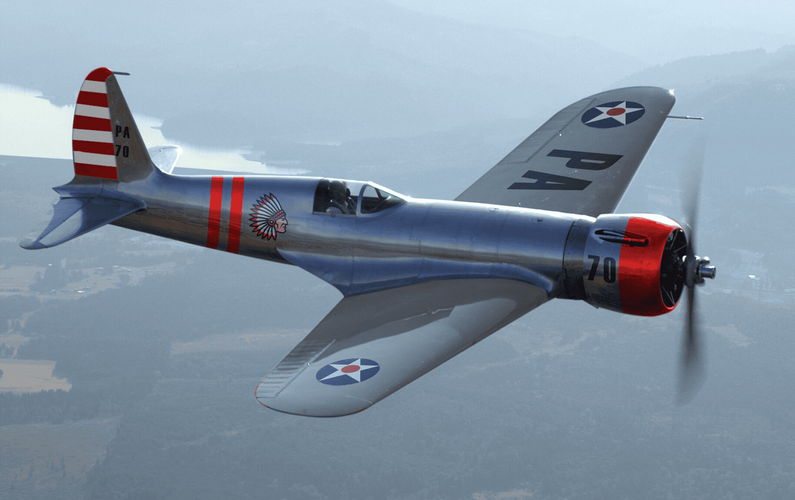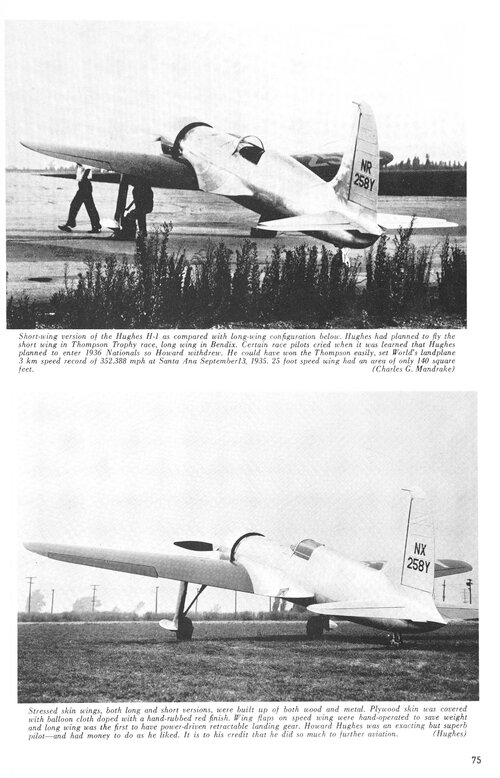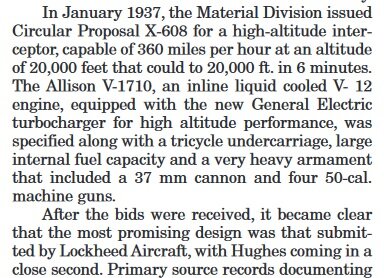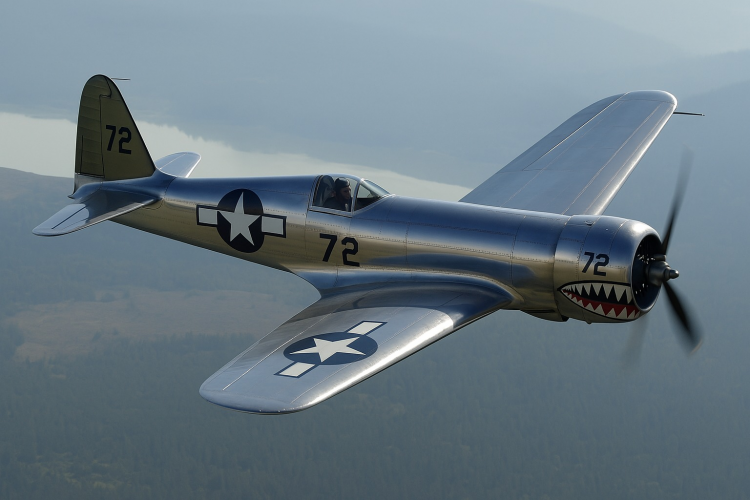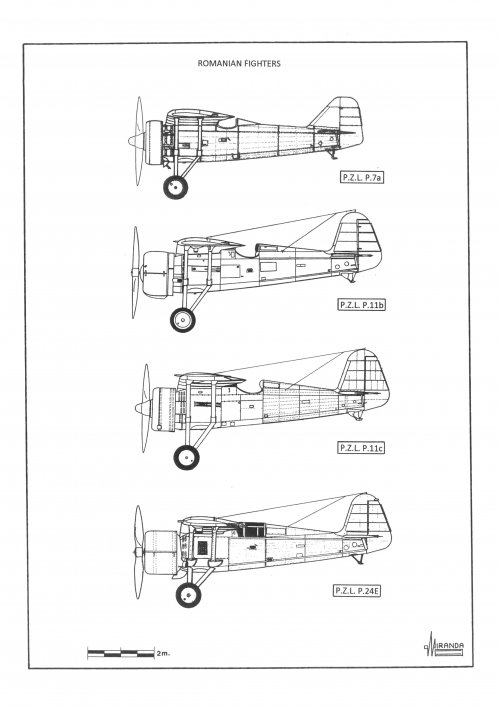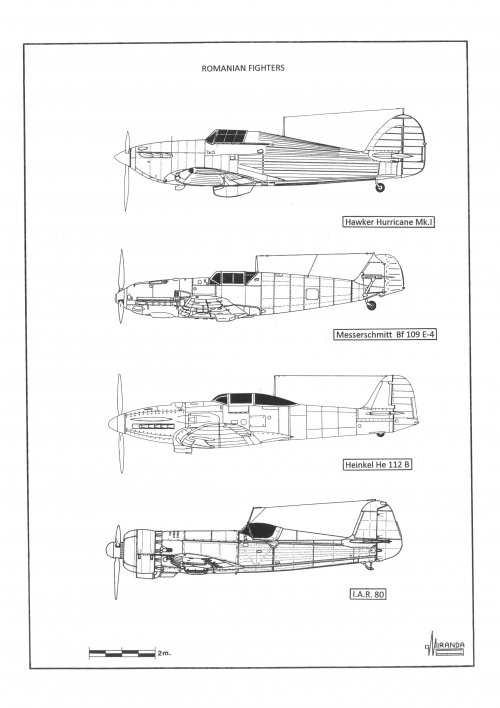NoOn the H-1/Zero myth

Did Howard Hughes Design Japan's Zero Fighter?
The truth behind the rumor that Howard Hughes designed the Zero fighter plane used by Japan in World War II.www.historynet.com
You are using an out of date browser. It may not display this or other websites correctly.
You should upgrade or use an alternative browser.
You should upgrade or use an alternative browser.
Hughes H-1 Pursuit Variant
- Thread starter GTX
- Start date
PabloSniper
ACCESS: Confidential
- Joined
- 16 June 2024
- Messages
- 54
- Reaction score
- 63
Hi Greg,
was finally reading back through the site and found your post.
In 'McDonnell Douglas Aircraft Since 1920: Volume 2" Rene Francillon paints a rather different picture of Hughes pursuit notions.
To start with he states that, unbeknown to Dick Palmer and the crew building the H-1, Hughes had set up another crew to build a fighter variation for entry in the Air Corps Pursuit Competition scheduled at Wright Field in August of 1935. Nothing came of it as the fighter, which had been given the martial sounding designation XP-2, could not be completed in time for the competition. Evidently there was an incident where Hughes purposely misrepresented a statement made by the Air Corps project officer, this began the friction between Hughes and the Air Corps that was to reach a critical point with the D-2/XF-11 debacle.
The next chapter in the sage was that following his trans-continental record flight in the H-1B, Hughes ignored an informal request by the Air Corps to bring the aircraft to Wright Field and discuss a possible pursuit development. Instead Hughes had the aircraft placed in storage.
The final act was that after a little less than three years of storage the aircraft was 'transferred to the Timm Aircraft Company in a $100,000 dollar paper transaction..in 1940 a desultory effort was made to modify the aircraft into an all-metal fighter. Nothing came of the project and that was the end of the H-1 as fighter story.
Francillon does not mention what the modification would have entailed...and its possible that nobody left alive knows what was intended or actually done.
However, going from the fact that it was intended for the 1935 Pursuit competition and based on the entries from Seversky(XP-1), Curtiss(Hawk 75B) and Vought V-141(Northrop N3)...I'd say minimal change in appearance and a pair of Browning machine guns, one .30 and one .50, firing through the propeller. May do that with the 'long-wing' version in the CMR twin-kit.
Cheers, Jon
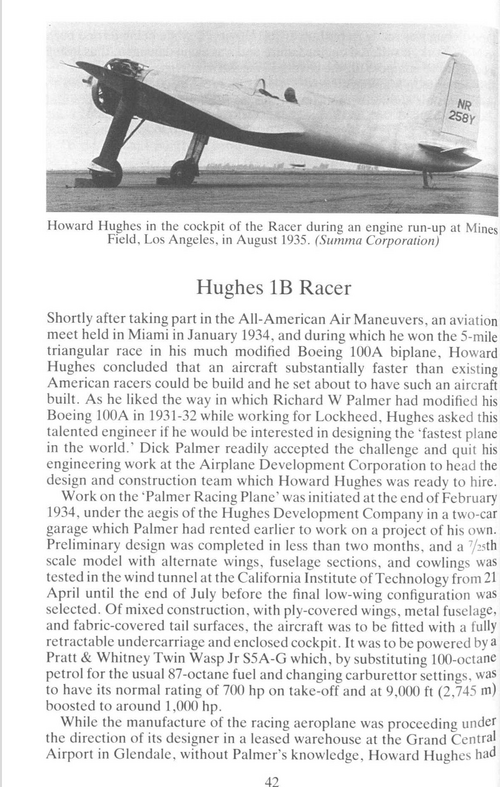
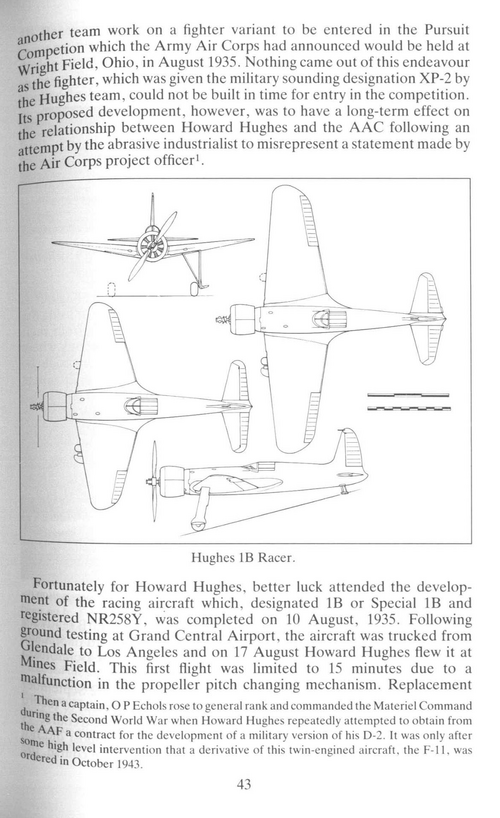
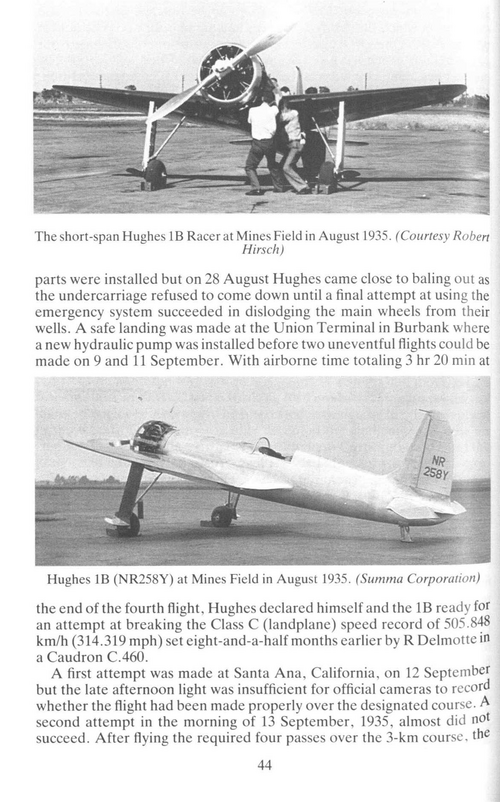
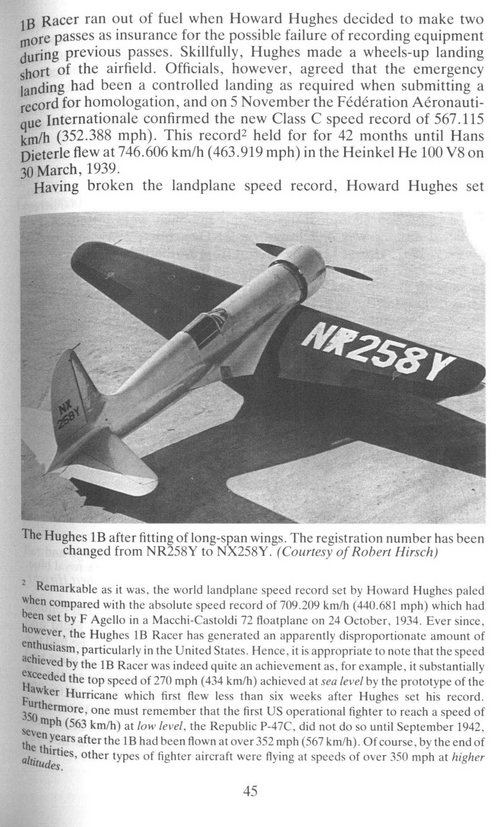
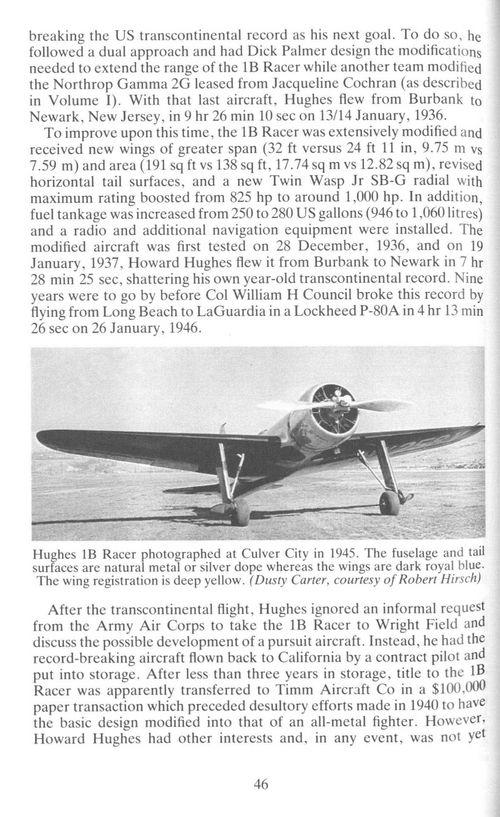
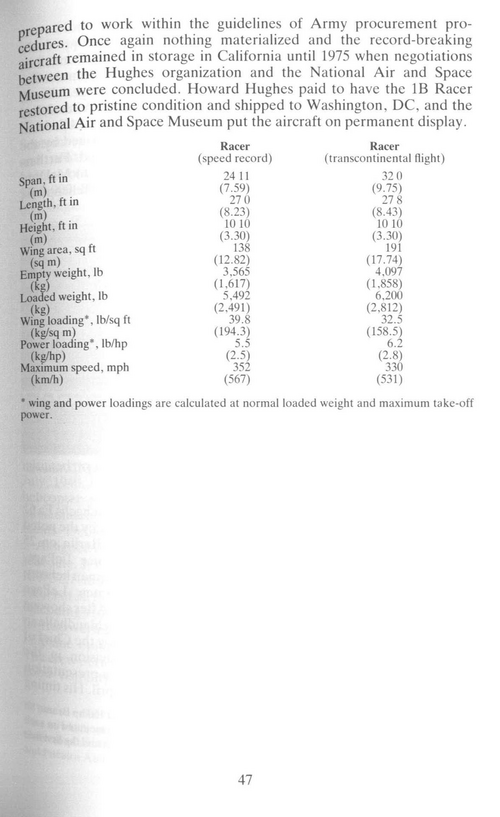
However, there is an error on page 47.
Because it states 330 miles as the maximum speed, whereas 330 miles was the average speed.
Because as Howard Hughes himself says in this interview, he flew at 375 miles per hour.
Last edited:
PabloSniper
ACCESS: Confidential
- Joined
- 16 June 2024
- Messages
- 54
- Reaction score
- 63
- Joined
- 1 May 2007
- Messages
- 2,595
- Reaction score
- 1,965
Re: Hesham's suggestion that the XP-2 was also the D-1, in the article linked HERE, that after the rejection of the XP-2 proposal, Hughes submitted a design to the requirement which led to the Lockheed P-38.
As this design was to have been twin engined, like the D-2, could this have been the D-1 ?
cheers,
Robin.
As this design was to have been twin engined, like the D-2, could this have been the D-1 ?
cheers,
Robin.
PabloSniper
ACCESS: Confidential
- Joined
- 16 June 2024
- Messages
- 54
- Reaction score
- 63
- Joined
- 26 May 2006
- Messages
- 34,894
- Reaction score
- 15,758
My dear Robunos,Re: Hesham's suggestion that the XP-2 was also the D-1, in the article linked HERE, that after the rejection of the XP-2 proposal, Hughes submitted a design to the requirement which led to the Lockheed P-38.
As this design was to have been twin engined, like the D-2, could this have been the D-1 ?
cheers,
Robin.
Thst's not right, the competitor from Hugbes to X-608 contest was H-2,and it was not D-1.
- Joined
- 25 July 2007
- Messages
- 4,299
- Reaction score
- 4,196
... Thst's not right, the competitor from Hugbes to X-608 contest was H-2,and it was not D-1.
Are we quite sure about that?
Robin was talking about the attached clipping from Air Power History, Fall 2007, pg 37.
Later, on the same page is this: "In later years [Hughes] would accuse Lockheed of stealing his design, but there is no evidence for this." Footnotes explain that this claim sprang from Lockheed hiring some of Hughes laid-off employees in the Autumn of 1936. While testifying before Congress in 1947, "Hughes insinuated that Lockheed had gotten the idea for two-engine fight[ers] from his former employers." (Pg. 39)
Thus, we are talking about a 1936 interceptor design which the USAAC had specified was to be powered by 2 x V-1710 V12s fitted with GE turbosuperchargers. So, what exactly prompted Howard Hughes' insinuation of design theft by Lockheed? It strongly suggests a twin-boomed lay-out (possibly with turbosuperchargers set aft).
AFAIK, the initial design for the H-2 had a conventional fuselage with twin endplate-style tails. The nacelles of the wind tunnel model for that first H-2 configuration are somewhat amorphous but suggest radial engines rather than the 'pointier' shape of early Allisons.
-- https://www.secretprojects.co.uk/threads/hughes-d-2-d-5-and-xf-11.5974/#post-49855
Attachments
- Joined
- 8 March 2009
- Messages
- 1,056
- Reaction score
- 1,298
I've posted the designs in one of the other threads on Hughes aircraft. They were conventional, non-boom twins.
Start at page 27161 here; https://www.google.com/books/edition/Investigation_of_the_National_Defense_Pr/e8Ga3wsfU5kC?hl
Start at page 27161 here; https://www.google.com/books/edition/Investigation_of_the_National_Defense_Pr/e8Ga3wsfU5kC?hl
- Joined
- 25 July 2007
- Messages
- 4,299
- Reaction score
- 4,196
Thanks for the reminder, sienar.
Interesting to see that both Hughes designs to specification X-608 - given as the single-seat H-1 and the twin-seat H-2 - were still powered by two Twin Wasp Juniors "although they do provide for the use of [the requested] Allison V-1710 engines instead of the Pratt & Whitney R-1535-5 engines." (pg 27159)[/B]
Interesting to see that both Hughes designs to specification X-608 - given as the single-seat H-1 and the twin-seat H-2 - were still powered by two Twin Wasp Juniors "although they do provide for the use of [the requested] Allison V-1710 engines instead of the Pratt & Whitney R-1535-5 engines." (pg 27159)[/B]
- Joined
- 26 May 2006
- Messages
- 34,894
- Reaction score
- 15,758
Are we quite sure about that?
Of course I am sure,it's opinion of my dear Mr. Tony Buttler.
PabloSniper
ACCESS: Confidential
- Joined
- 16 June 2024
- Messages
- 54
- Reaction score
- 63
Going completely off topic and without implying any inspiration whatsoever, doesn't this hypothetical Hughes pursuit plane look a tad like this aircraft?

 en.wikipedia.org
en.wikipedia.org

IAR 80 - Wikipedia
PabloSniper
ACCESS: Confidential
- Joined
- 16 June 2024
- Messages
- 54
- Reaction score
- 63
In fact, it's the other way around, the IAR-80 looks like the H-1 Racer, as the H-1 is much older.Going completely off topic and without implying any inspiration whatsoever, doesn't this hypothetical Hughes pursuit plane look a tad like this aircraft?

IAR 80 - Wikipedia
en.wikipedia.org
But you are right!
Despite the superficial similarities, the IAR-80 is based on the PZL-11/24, both having been produced at IAR under licence. Or more precisely the fuselage is, mated with a low wing, redesigned front part, retractable gear etc.
The IAR 80 was a version of the PZL
In January 1936 the Rumanian government acquired the manufacturing license of the P.Z.L. P.11c fighter. The I.A.R. firm built 95 units as P.11F (380 kph). In November they also acquired the manufacturing license for 25 units of the P.Z.L. P.24E (430 kph), but the model became obsolete that same month when it was learned that the Polikarpov I-16 Type 5, a low wing monoplane with retractable landing gear capable of flying at 454 kph, had entered into combat in Spain beating the Heinkel He 51 of the Legion Condor. Three months later the Messerschmitt Bf 109 B-1 (462 kph) entered service with the Luftwaffe.
At the end of 1936 the Pulawski fighters had reached the limit of their development; the drag generated by the bracing struts and the spatted landing gear prevented them from exceeding 430 kph. When knowing the performance of the Bf 109 B-1, I.A.R. started the design of a low-wing version of the P.24E called I.A.R. 80. The new fighter, powered by an I.A.R.14K radial engine, should use the fuselage and tail surfaces of the P.24, attached to a wing based on the Savoia Marchetti S.M.79B bomber wing (decreasing its dimensions by 50 per cent) containing a retractable Messier undercarriage.
One month later the annexation of Sudetenland to the Third Reich, Romania acquired twelve Hawker Hurricane Mk.IA (518 kph), after learning that the Bf 109 B-2 (462 kph) had come into service. An even faster version, called Bf 109 E-1 (574 kph) did it in February 1939.
On 15 March 1939 Germany invaded the remainder of Czechoslovakia. Nine days later Romania was forced to sign an economic treaty to supply oil to the Reich from the fields of Ploesti, in exchange for thirty fighters Heinkel 112E. In April, the prototype of the I.A.R.80 flew at 510 kph. A month later Romania signed a treaty of territorial integrity with Great Britain and France.
On 23 August 1939 the Nazi-Soviet non-aggression pact was signed. Five days later the Hawker Hurricanes Mk.IA and the first He 112E were delivered to the Royal Rumanian Air Force (FARR). On 1 September 1939 the Third Reich invaded Poland, followed by a Soviet attack on the day 17. At the end of that year the FARR ordered fifty Messerschmitt Bf 109 E-3 and hundred I.A.R. 80 fighters.
On 28 June 1940 the U.S.S.R. annexed the Romanian regions of Bessarabia and northern Bukovina. Two months later Germany and Italy forced Romania to cede northern Transylvania to Hungary and southern Dobruja to Bulgaria. On 23 November 1940, as a result of a coup, Romania signed the Axis Tripartite Pact and the FARR received the first Bf 109 E-3. Between February and May 1941 I.A.R. delivered the first batch of seventy I.A.R. 80 fighters. On 22 June, Romania was forced to participate in the invasion of the U.S.S.R. Operation Barbarossa on the pretext of recovering Bessarabia.
At that time the FARR had fifty-eight I.A.R. 80/80A, twenty-three He 112E, thirty Bf 109 E-3, ten Hawker Hurricane Mk.IA, twenty P.Z.L. P.24E, thirty-two P.Z.L. P.11F and twenty-four P.Z.L. P.11c from the Polish Air Force. In combat the P.Z.L. fighters were superior to the Soviet I-16 during the Bessarabian campaign and being used as fighter-bombers from October 1941.
The Hurricanes were soon useless, due to lack of spares, and the He 112E, fitted with 20 mm cannons, mainly used on strafing missions, suffering heavy losses because of the absence of armour. The FARR was forced to depend more and more on the I.A.R. 80, a fighter that equalled the Bf 109 E in climb and manoeuvrability, able to reach 500 kph with an engine of just 930 hp.
The I.A.R. 80 of the first production batch suffered engine problems and failures of the undercarriage retraction system. They were armed with 4 x 7.92 mm FN/Browning machine guns. The IAR 80A with 6 x 7.92 mm FN and 1,025 hp I.A.R. K14 1000A engine was delived in May 1941. The I.A.R. 80B had larger wings, a 4 x 7.92 FN armament and 2 x 13.2 FN machine guns. It was delivered in June 1942, taking part in the battle of Stalingrad.
The 13.2 mm FN were replaced by two 20 mm Ikaria cannons in the I.A.R. 80C, delivered on December 1942.
The I.A.R. 81 was built as a dive bomber, armed with 6 x 7.92 mm FN machine guns. The fighter version, called I.A.R. 81C, was armed with 2 x 7.92 FN and two 20 mm MG 151 cannons. The four-hundred-and-seventy-four I.A.R. 80/81 that had been built achieved 500 aerial victories during the Second World War. From 1942 they were gradually outclassed by the newest Soviet fighters. In 1943 all aircraft were relegated to home defence.
The I.A.R. 14K engine could not overcome the 1,025 hp and the Germans denied the license to manufacture the 1,700 hp BMW 801 radial engine. Early 1942 a 1,200 hp Jumo 211 in-line engine, from a Savoia-Marchetti S.M. 79B bomber, was installed in the I.A.R. 80 c/n 111, but during the flight tests the aircraft experienced destructive vibration problems and the continuation of the experiments was dismissed. At the end of 1943 a DB 601 Aa from a Bf 109 E-3 was installed in the I.A.R. 80 c/n 13, doing some test flights.
On 29 June 1943 the I.A.R. 81C c/n 326 was experimentally equipped with a 1,475 hp DB 605A engine.
On 24 August 1944, before the Soviet advance, Romania changed sides carrying out operations of combat against the Third Reich until the end of the Second World War in Europe.
In January 1936 the Rumanian government acquired the manufacturing license of the P.Z.L. P.11c fighter. The I.A.R. firm built 95 units as P.11F (380 kph). In November they also acquired the manufacturing license for 25 units of the P.Z.L. P.24E (430 kph), but the model became obsolete that same month when it was learned that the Polikarpov I-16 Type 5, a low wing monoplane with retractable landing gear capable of flying at 454 kph, had entered into combat in Spain beating the Heinkel He 51 of the Legion Condor. Three months later the Messerschmitt Bf 109 B-1 (462 kph) entered service with the Luftwaffe.
At the end of 1936 the Pulawski fighters had reached the limit of their development; the drag generated by the bracing struts and the spatted landing gear prevented them from exceeding 430 kph. When knowing the performance of the Bf 109 B-1, I.A.R. started the design of a low-wing version of the P.24E called I.A.R. 80. The new fighter, powered by an I.A.R.14K radial engine, should use the fuselage and tail surfaces of the P.24, attached to a wing based on the Savoia Marchetti S.M.79B bomber wing (decreasing its dimensions by 50 per cent) containing a retractable Messier undercarriage.
One month later the annexation of Sudetenland to the Third Reich, Romania acquired twelve Hawker Hurricane Mk.IA (518 kph), after learning that the Bf 109 B-2 (462 kph) had come into service. An even faster version, called Bf 109 E-1 (574 kph) did it in February 1939.
On 15 March 1939 Germany invaded the remainder of Czechoslovakia. Nine days later Romania was forced to sign an economic treaty to supply oil to the Reich from the fields of Ploesti, in exchange for thirty fighters Heinkel 112E. In April, the prototype of the I.A.R.80 flew at 510 kph. A month later Romania signed a treaty of territorial integrity with Great Britain and France.
On 23 August 1939 the Nazi-Soviet non-aggression pact was signed. Five days later the Hawker Hurricanes Mk.IA and the first He 112E were delivered to the Royal Rumanian Air Force (FARR). On 1 September 1939 the Third Reich invaded Poland, followed by a Soviet attack on the day 17. At the end of that year the FARR ordered fifty Messerschmitt Bf 109 E-3 and hundred I.A.R. 80 fighters.
On 28 June 1940 the U.S.S.R. annexed the Romanian regions of Bessarabia and northern Bukovina. Two months later Germany and Italy forced Romania to cede northern Transylvania to Hungary and southern Dobruja to Bulgaria. On 23 November 1940, as a result of a coup, Romania signed the Axis Tripartite Pact and the FARR received the first Bf 109 E-3. Between February and May 1941 I.A.R. delivered the first batch of seventy I.A.R. 80 fighters. On 22 June, Romania was forced to participate in the invasion of the U.S.S.R. Operation Barbarossa on the pretext of recovering Bessarabia.
At that time the FARR had fifty-eight I.A.R. 80/80A, twenty-three He 112E, thirty Bf 109 E-3, ten Hawker Hurricane Mk.IA, twenty P.Z.L. P.24E, thirty-two P.Z.L. P.11F and twenty-four P.Z.L. P.11c from the Polish Air Force. In combat the P.Z.L. fighters were superior to the Soviet I-16 during the Bessarabian campaign and being used as fighter-bombers from October 1941.
The Hurricanes were soon useless, due to lack of spares, and the He 112E, fitted with 20 mm cannons, mainly used on strafing missions, suffering heavy losses because of the absence of armour. The FARR was forced to depend more and more on the I.A.R. 80, a fighter that equalled the Bf 109 E in climb and manoeuvrability, able to reach 500 kph with an engine of just 930 hp.
The I.A.R. 80 of the first production batch suffered engine problems and failures of the undercarriage retraction system. They were armed with 4 x 7.92 mm FN/Browning machine guns. The IAR 80A with 6 x 7.92 mm FN and 1,025 hp I.A.R. K14 1000A engine was delived in May 1941. The I.A.R. 80B had larger wings, a 4 x 7.92 FN armament and 2 x 13.2 FN machine guns. It was delivered in June 1942, taking part in the battle of Stalingrad.
The 13.2 mm FN were replaced by two 20 mm Ikaria cannons in the I.A.R. 80C, delivered on December 1942.
The I.A.R. 81 was built as a dive bomber, armed with 6 x 7.92 mm FN machine guns. The fighter version, called I.A.R. 81C, was armed with 2 x 7.92 FN and two 20 mm MG 151 cannons. The four-hundred-and-seventy-four I.A.R. 80/81 that had been built achieved 500 aerial victories during the Second World War. From 1942 they were gradually outclassed by the newest Soviet fighters. In 1943 all aircraft were relegated to home defence.
The I.A.R. 14K engine could not overcome the 1,025 hp and the Germans denied the license to manufacture the 1,700 hp BMW 801 radial engine. Early 1942 a 1,200 hp Jumo 211 in-line engine, from a Savoia-Marchetti S.M. 79B bomber, was installed in the I.A.R. 80 c/n 111, but during the flight tests the aircraft experienced destructive vibration problems and the continuation of the experiments was dismissed. At the end of 1943 a DB 601 Aa from a Bf 109 E-3 was installed in the I.A.R. 80 c/n 13, doing some test flights.
On 29 June 1943 the I.A.R. 81C c/n 326 was experimentally equipped with a 1,475 hp DB 605A engine.
On 24 August 1944, before the Soviet advance, Romania changed sides carrying out operations of combat against the Third Reich until the end of the Second World War in Europe.
Attachments
Similar threads
-
-
Aeromarine PG-1 Pursuit/Ground Attack Aircraft
- Started by Dynoman
- Replies: 21
-
-
-

